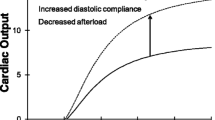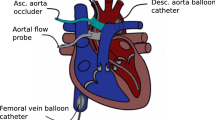Abstract
The maintenance of adequate blood circulation requires a sufficient ventricular contractility; in addition, to eject blood, the ventricles must first receive a sufficient volume, requiring a low diastolic stiffness. A simplified cardiovascular model was used to derive formulae for stroke volume (SV) as a function of atrial pressure and the ratio of ventricular end-systolic elastance to end-diastolic stiffness. A more complex cardiovascular model was used to assess the ability of the expressions to predict stroke volume under various steady-state conditions. The predicted SV correlated linearly with the model SV over a wide range of diastolic stiffnesses and systolic elastances. The formulae predict that with fixed right atrial pressure the SV is proportional to the ratio of end-systolic elastance to end-diastolic stiffness (GR) for the right ventricle, but relatively insensitive to the ratio (GL) for the left ventricle provided that GL is greater than GR. Model simulations confirmed this. When the right atrial pressure was not fixed increases in GR with fixed GL reduced the right atrial pressure with little change in SV. Similarly, varying GL with fixed GR produced little change in SV. The ratios highlight the importance of diastole to cardiac function.
Similar content being viewed by others
References
Amoore, J. N. (1987) Ventricular interdependence and the transient response of the left ventricle to inspiration: a model study.Cardiovasc. Res.,21, 407–415.
Amoore, J. N. andSantamore, W. P. (1989) Model studies of the contribution of ventricular interdependence to the transient changes in ventricular function with respiratory efforts.,23, 683–694.
Beyar, R., Sideman, S. andDinnar, U. (1984) Cardiac assist by intrathoracic and abdominal pressure variations: a mathematical study.Med. & Biol. Eng. & Comput.,22, 507–515.
Beyar, R., Hausknecht, M.J., Halperin, H. R., Yin, F. C. P. andWeisfeldt, M. L. (1987) Interaction between cardiac chambers and thoracic pressure in intact circulation.Am. J. Physiol.,253, H1252.
Bove, A. A. andSantamore, W. P. (1981) Ventricular interdependence.Progr. Cardiovasc. Dis.,23, 365–388.
Burton, A. C. (1972)Physiology and biophysics of the circulation. An introductory text. Year Book Medical Publishers Inc., Chicago.
Dougherty, A. H., Naccarelli, G. V., Gray, E. L., Hicks, C. H. andGoldstein, R. A. (1984) Congestive heart failure with normal systolic function.Am. J. Cardiol.,54, 778–782.
Feneley, M. P., Olsen, C. O., Glower, D. D. andRankin, J. S. (1989) Effect of acutely increased right ventricular afterload on work output from the left ventricle in conscious dogs. Systolic ventricular interaction.Circ. Res.,65, 135–145.
Gaasch, W. H. (1990) Diastolic dysfunction of the left ventricle: importance to the clinician.Adv. Intern. Med.,35, 311–340.
Gunther, B. andLandis, E. M. (1952) Cardiac resistance to flow; pressure-flow relationships in quiescent and beating turtle heart.Am. J. Physiol.,169, 412–422.
Guyton, A. C., Jones, C. E. andColeman, T. G. (1973)Circulatory physiology: cardiac output and its regulation. W. B. Saunders Co., Philadelphia.
Hardy, H. H., Collins, R. E. andCalvert, R. E. (1982) A digital computer model of the human circulatory system.Med. & Biol. Eng. & Comput.,20, 550–564.
ICRP (1974) Reference Man. Report of the Task Group on Reference Man, International Commission on Radiological Protection, No. 23.
Lin, C-K., Levenson, H. andYamashiro, S. M. (1987) Optimization of coronary blood flow during cardiopulmonary resuscitation (CPR).IEEE Trans.,BME-34, 473–481.
Maughan, W. L., Shoukas, A. A. K., Sagawa, K. andWeisfeldt, M. L. (1979) Instantaneous pressure-volume relationship of the canine right ventricle.Circ. Res.,44, 309–315.
Maughan, W. L., Sunagawa, K. andSagawa, K. (1987) Ventricular systolic interdependence: volume elastance model in isolated canine hearts.Am. J. Physiol.,253, H1381-H1390.
Maughan, W. L. andOikawa, R. Y. (1989) Right ventricular function. InHeart-lung interactions in health and disease.Scharf, S. M. andCassidy, S. S. (Eds.), Marcel Dekker, Inc., New York, 179–220.
Mirsky, I. (1984) Assessment of diastolic function: suggested methods and future considerations.Circ.,69, 836–841.
Packer, M. (1990) Abnormalities of diastolic function as a potential cause of exercise intolerance in chronic heart failure.Circ.,81, Suppl. III, III1-III7.
Permutt, S., Wise, R. A. andSylvester, J. T. (1985) Interaction between the circulatory and ventilatory pumps. InThe thorax.Roussos, C. andMacklem, P. T. (Eds.), Marcel Dekker, Inc., New York, 701–735.
Santamore, W. P., Constantinescu, M. andLittle, W. C. (1987) Direct assessment of right ventricular transmural pressure.Circ.,75, 744–747.
Santamore, W. P. andBurkhoff, D. (1991) Hemodynamic consequences of ventricular interaction as assessed by model analysis.Am. J. Physiol.,260, H146-H157.
Sarnoff, S. J. (1955) Myocardial contractility as described by ventricular function curves: observations on Starting's law of the heart.Physiol. Rev.,35, 107–122.
Snyder, M. F. andRideout, V. C. (1969) Computer simulations studies of the venous circulation.IEEE Trans.,BME-16, 325–334.
Soufer, R., Wohlgelernter, D., Vita, N., Amuchestegu, M., Sorstman, D., Berger, H. J. andZaret, B. L. (1985) Intact systolic left ventricular function in clinical congestive heart failure.Am. J. Cardiol.,55, 1032–1036.
Suga, H. andSagawa, K. (1974) Instantaneous pressure-volume relationships and their ratio in the excised, supported canine left ventricle.Circ. Res.,35, 117–126.
Suga, H., Sagawa, K. andKostiuk, D. P. (1976) Controls of ventricular contractility assessed by pressure-volume ratio, Emax.Cardiovasc. Res.,10, 582–587.
Taylor, R. R., Covell, J. W., Sonnenblick, E. H. andRoss, J. (1967) Dependence of ventricular distensibility on filling of the opposite ventricle.Am. J. Physiol.,213, 711–718.
Author information
Authors and Affiliations
Rights and permissions
About this article
Cite this article
Amoore, J.N. Theoretical analysis of the relationship between the ratio of ventricular systolic elastance to diastolic stiffness and stroke volume. Med. Biol. Eng. Comput. 30, 605–612 (1992). https://doi.org/10.1007/BF02446792
Received:
Accepted:
Issue Date:
DOI: https://doi.org/10.1007/BF02446792




